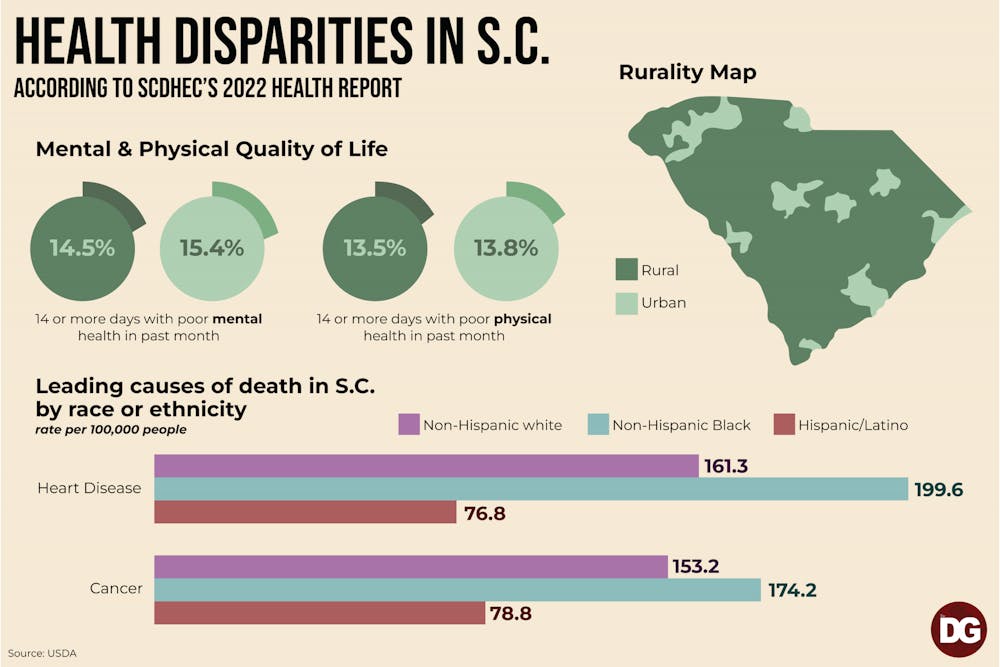USC's School of Medicine has been working to help address health disparities in South Carolina that were recently emphasized by the South Carolina Department of Health and Environmental Control's (SCDHEC) 2022 health report.
The health report is an annual release detailing health statistics in South Carolina that defines the general health of people in the state. Throughout all of the data reported by SCDHEC, there are many examples of health disparities due to demographic characteristics and location. These discrepancies are caused by social determinants of health.
Social determinants of health are the root causes of disparities that include things such as environmental conditions, economic status and demographic characteristics, Les Hall, dean of the USC School of Medicine, said.
“If you want to understand social determinants of health, you can read about it or you can watch a PowerPoint presentation. You can also go work in a homeless shelter and figure out that some of the people there don’t go to medical appointments, not because they don’t care, but they don’t have access to transportation,” Hall said.
Race and ethnicity were considered a lot in the SCDHEC data report when comparing data, which emphasizes the disparities. An example of this can be seen in the data for leading causes of death. While there were multiple factors reported, SCDHEC said that non-Hispanic Black people die of heart disease at a 23.7% higher rate than their non-Hispanic white counterparts.
“(The disparities) began with our racist history in this country and continue to persist largely because of that,” Carrie Draper, senior research associate for USC's Department of Health Promotion, Education and Behavior, said. “(For example), we still have not expanded Medicaid for people to have more access to health insurance, which disproportionately impacts people who are Black in the state.”
The USC School of Medicine is looking to increase opportunities for learning about health disparities in volunteer services, as well as give hands-on learning in the field.
While race is commonly looked at when learning about and studying these disparities, it should not be the only factor addressed, according to Hall.
"It turns out that many of these clinical predictive models have race built in as one of the factors that determines risk for something," Hall said. "And it turns out when you look critically at that ... In most cases it's not race that is the risk factor for that, It is other social determinants of health such as people with a certain race may be in an area that has less access to health care services."
The USC School of Medicine is also involved with a free medical clinic that has been providing service for over two decades to people who can’t afford healthcare or insurance. The clinic is run by Todd Crump, an alumnus of USC who got involved while he was in school. Many students at the school of medicine volunteer here, although it's not school-run.
“For as long as I think the medical school has been around during the time that free medical clinic has existed, we have had medical students who have donated services there, and … we encourage students to do that. It's not a requirement,” Hall said. “Most of our students do some type of service learning at some point during their education.”
A major factor influencing general health status in South Carolina was also found to be how rural counties in the state tend to have a lower life expectancy.
“A lot of rural hospitals in South Carolina are operating in red,” Peiyin Hung, an assistant professor at the USC School of Public Health and deputy director at the Rural and Minority Health research center, said. “So all these rural hospitals, they don't really have high acuity care capacity.”
In addition to this, there are rural counties in South Carolina without the means to get groceries and food. Food insecurity contributes a lot to health disparities in areas called food deserts. Counties with large areas of food deserts included Colleton, Berkely, Georgetown and Kershaw, according to SCDHEC.
“When it comes to food insecurity we have some counties that at times, I think we've had situations where there's literally not been a grocery store in the county,” Draper said.
To address this, similarly, the USC School of Medicine is tying this into its curriculum to advocate for health disparities.
"You could work at a food bank such as FoodShare, which many of our students do ... but we often have not tied that work into their curricular learning," Hall said. "We are making more explicit efforts to ensure that faculty are helping to assist the students as they process what they are learning from those volunteer services."
The USC School of Medicine was ranked No. 1 for graduates practicing in areas that don't have enough healthcare professionals. The continuation of the efforts to address health disparities in South Carolina supports that ranking, according to Hall.
"The fact that we're the No. 1 school in the country in terms of our students working in underserved areas suggests to me that it's something that our students believe is important as well," Hall said.

